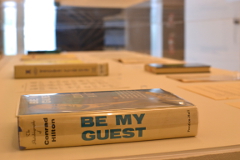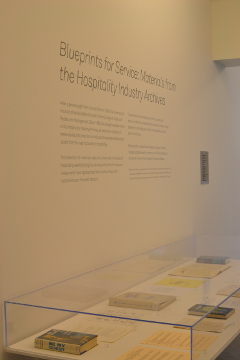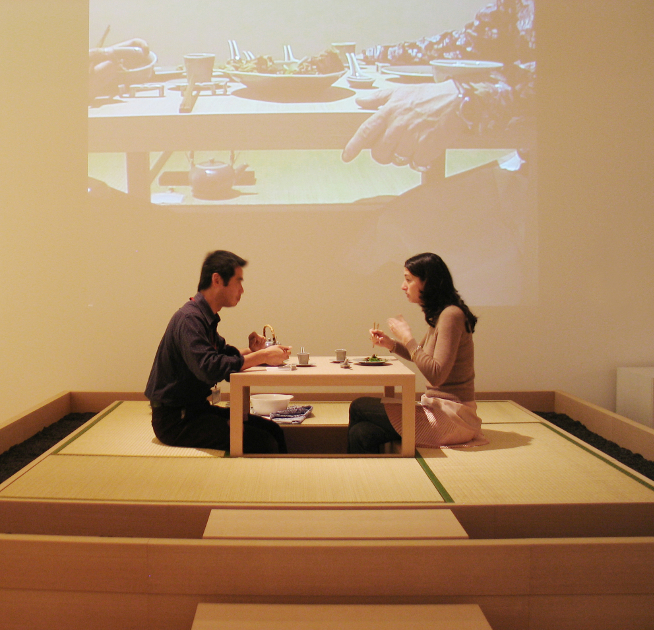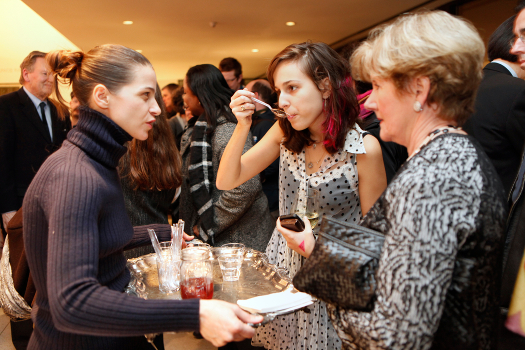Illa Gaunt has resided in Houston since April 2012, after re-locating from London where she worked as the Gallery Manager at Rountree Fine Art. She is currently pursuing her Masters in Art History at the University of Houston and previously received degrees from Christie's Education London and Vanderbilt University, both in Art History.
Blaffer's Latest Art Exhibit "Feast" Explores Complexities of Hospitality
Illa Gaunt
Nov 09, 2013
The complexity of hospitality is one of the concepts under investigation in the works currently on display in
Feast: Radical Hospitality in Contemporary Art at the University of Houston's Blaffer Art Museum (closing December 7th). The show, which was originally organized by the Smart Museum of Art at the University of Chicago, includes over thirty artists and artist collectives, with four additional works commissioned by Blaffer for the Houston show.
The University of Houston is a fitting place to host a hospitality-themed exhibition, as it's also home to the Hilton College's Hospitality Industry Archives, the largest repository of memorabilia, historical documents, and corporate and personal letters from the leading brands in hospitality. As part of my curatorial internship with Blaffer, I was given the opportunity to curate a supplemental exhibition of the archival materials, titled
Blueprints for Service, which is on view at Blaffer and in the foyer of the Hilton College. The collection of documents and objects on display takes a close look at intricacies of hospitality, showing the fervency with which hotels, restaurants and airlines have approached their customers over the past century. By exploring decorum and etiquette, pieces in both
Feast and
Blueprints help us to consider one of the most important components of hospitality: the relationship between host and guest.
The Dining Project
In one of the prominent artworks in
Feast, Lee Mingwei takes on the role of host by sharing dinner with a stranger.
The piece was born out of Lee's desire to make friends during his first year of graduate school at Yale, when he placed posters around campus to invite classmates to his home for conversation and food sharing. At first Lee didn't see his one-on-one dinners as art. However, his elaborate custom of preparing dishes, serving the meal and engaging in conversation with dinner partners challenged the distinction between the ritual of dining and performance art. As part of the Blaffer exhibition, Lee performed the work by preparing dinner after hours in the museum for three guests chosen by lottery.
The aesthetics of hospitality are an important component of
The Dining Project and are also a theme in the materials on display from the Hilton archives. Selections from procedural manuals illuminate the extensive systems, techniques, preparation and organization involved in such tasks as slicing pie, making a bed, carrying a tray and setting a table. The Harbour Castle Hotel provides step-by-step directions for catching a drip from a coffeepot, and the Fairmont Hotel Venetian Room instructs a cocktail waitress to position herself in an "idle stance": " When not occupied, the Waitress will stand with one foot forward, and lean backward in the manner of a fashion model. If sufficiently away from guests, she may also lean slightly against the back of a chair or settee, keeping part of her weight on her feet." In a way, these manuals provide blueprints for rituals around hospitality and the gendered labor required to maintain a smooth relationship between host and guest.
The Greeting Committee
Ana Prvacki's work also explores relationships between host and guest by transforming a hospitable custom into a social performance.
In preparation for the piece, Prvacki traveled to Houston months before the exhibition and, along with students from the UH's Hilton College of Hotel and Restaurant Management, prepared Serbian jam, or
slatko, using locally harvested strawberries and her mother's recipe. In Serbian tradition, a spoonful of
slatko, which literally means "sweet," is given to guests upon entering the home to sweeten their visit. Translated to the museum's entrance on the occasion of
Feast, the work facilitates encounters between the museum as host and museum visitor as guest, sweetening the visitor's tongue so that they will say nice things about the exhibition. On opening night of
Feast at Blaffer, students and volunteers presented trays of the sweet jam to museum visitors.
The Greeting Committee explores the experience of hospitality by highlighting ideas around etiquette and civility. The presentation of
slatko is meant to create a sweetened first impression; however, Prvacki is also fascinated by moments when hospitality goes awry and creates uncomfortable situations. Several of the documents in
Blueprints expose friction in the often-complex relationship between host and guest. One item is an excerpt from a Hilton training manual titled "Dealing with Criticism and Anger," which presents a scenario between a hotel employee and a disgruntled guest. The piece, one of Prvacki's favorites when she visited the archives last year, plays out like the script from a badly written soap opera. In the training scenario Mrs. Appleton calls down to guest services to complain about the quality of her pillows: "In a hotel like this, I'd've thought you'd have softer pillows. The ones on my bed are like bricks! But hotels are all alike- nobody really cares anymore." The guest services employee replies she will have housekeeping send new pillows up to Mrs. Appleton, only to have the grouchy guest respond: "All right but see you do it right away- I don't want to be bothered this evening." There is also a complaint letter about "nauseating" poached eggs from an irritated yet eloquent guest at the Hotel Nile accompanied by a cordial apology letter from Conrad Hilton.
 |
The Hilton College archives offers visitors a behind-the-scenes look at the methodologies of hospitality and, along with
Feast, manages to breakdown the hosting process in all its forms by exposing the intricate rituals, codes of etiquette, and elaborate customs involved in the relationship between host and guest.





Comments (0)
Add a Comment